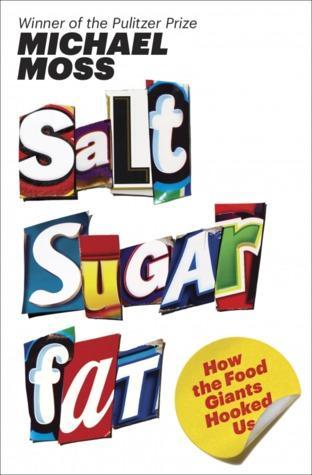Book: Salt Sugar Fat: How the Food Giants Hooked Us by Michael Moss
Genre: nonfiction
Publisher: Random House
Publication date: 2013
Pages: 446
Source: Library
 Summary: I reviewed Part 1, Sugar, in March: Book Review: Salt Sugar Fat by Michael Moss (Part 1) and I still like the summary I wrote then:
Summary: I reviewed Part 1, Sugar, in March: Book Review: Salt Sugar Fat by Michael Moss (Part 1) and I still like the summary I wrote then:
Michael Moss, winner of the Pulitzer Prize for explanatory reporting in 2010 for research and writing about food safety issues, takes a longer and deeper look at the food industry in Salt Sugar Fat: How the Food Giants Hooked Us. Delving into the historical background and elucidating the current state of things, Salt Sugar Fat examines the obesity epidemic by shining a light on the ingredients that go into modern processed food.
Thoughts: In Part One, Sugar, I learned that there’s a bliss point of sweetness that manufacturers carefully tune in their foods — too little and our taste buds don’t get excited, too much and they’re overwhelmed. The lengths that food manufacturers go to perfect that level of sugar is scary. Scarier still is to learn that fat doesn’t have a bliss point.
…manufacturers could crank up the fat content as high as they wanted, and unless people studied the nutrition label carefully, the fat would get eaten in bliss without setting off any alarms in the body’s system that help regulate our weight by telling us we are eating too much. p. 159
Of course, we know, intellectually that fat is bad for us. That’s why so many of us reduced the amount of meat, especially beef and pork, that we were eating. So where is all that fat coming from now? Cheese. But not the good stuff — the square of a quality artisan cheese that you set on the counter for an hour to warm up before enjoying each small bite. What America is eating isn’t even allowed to be called cheese, much of it in things like frozen dinners, especially pizza, and snack foods.
Americans now eat as much as 33 pounds or more of cheese and pseudo-cheese products a year, triple the amount we consumed in the early 1970s. During that same time, beverage makers managed only to double the per capita consumption of carbonated soft drinks to 50 gallons a year; in fact, in recent years they have seen a dropoff, as consumers switched to other sugary drinks. America’s intake of cheese, by contrast, continues to swell increasing 3 pounds per person since 2001. p. 163
This part discusses Lunchables which started as a way to revive sales of bologna because moms knew it was too high in salt and saturated fat. But, somehow, putting it in a cute convenient box with cheese and crackers (adding more salt and fat) made it acceptable again. First, it was advertised to moms as a special occasion gift to a child on extra-busy days. But, the real allure is for kids who get to play with their food in choosing how they construct their lunch from the fixings in the box while showing off to all their friends.
Do you know about “checkoffs?” It’s money paid by dairy and beef farmers to the Department of Agriculture which is then used for marketing including promotions like “The Wisconsin,” a Domino’s pizza with “six cheeses on top and two more in the crust.” p. 234.
The dollars for marketing beef added up to more than $80 million a year, and over the years, the total money raised has topped $2 billion. That is essentially, $2 billion for selling America on more beef, compared with the $6.5 million the USDA’s nutrition center gets each year to nudge Americans in the other direction — of cutting back, not only on fat but on sugar and salt as well. It hasn’t been a fair fight. p. 223
Sheesh. It’s pretty apparent that our government doesn’t have a consistent vision for our food system.
Even when processed food companies try to do the right thing, not so much out of the goodness of their heart as an awareness that eventually consumers would wise up as they did on tobacco, they fail. Kraft had an advisory board for awhile about obesity and put a caps on the salt, sugar, and fat in various categories of its food. But when they needed to compete with some new offerings by Hershey, they just invented a new category of cookie with a higher cap on fat. Thus, we get the Triple Double Oreo. And, now, Oreos are being sold in the most remote villages of India.
Well, I can’t wait to see what comes in the Part 3, Salt.
Appeal: Any one who cares about what we’re eating.
Reviews: Since it took me so long to get back to this book (the France trip was a bit of a distraction), other people have had a chance to review it:
Aarti at BookLust covered an aspect that I didn’t get to about the responsibilities that companies have and don’t have: Salt Sugar Fat: How the Food Giants Hooked Us.
Melissa of the Feminist Texican [Reads] reviewed Salt Sugar Fat for Weekend Cooking last month and I loved the comments, too: Salt Sugar Fat: How the Food Giants Hooked Us
Jen, the Devourer of Books, liked the audio version: Salt Sugar Fat by Michael Moss – Audiobook Review
Did I miss anyone’s review of Salt Sugar Fat? I’ll link to other reviews when I write about Part 3.
 I’m linking this partial review of Salt Sugar Fat to Weekend Cooking at Beth Fish Reads where, this week, we learn how she uses zucchini in her kitchen: Weekend Cooking: The Kitchen Journal–Zucchini Edition.
I’m linking this partial review of Salt Sugar Fat to Weekend Cooking at Beth Fish Reads where, this week, we learn how she uses zucchini in her kitchen: Weekend Cooking: The Kitchen Journal–Zucchini Edition.

